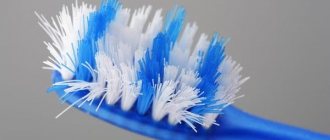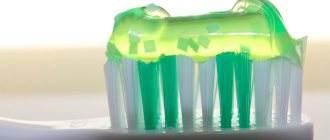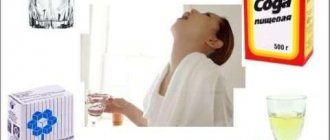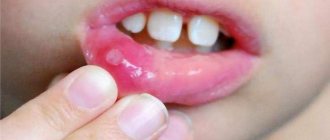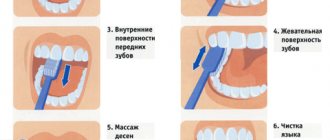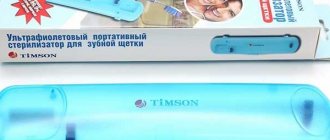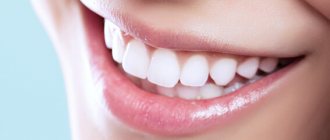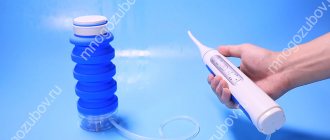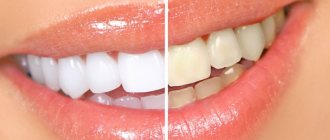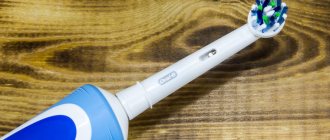Cleaning products
Cleaning teeth with braces is a multi-step procedure. There is a different tool for each stage.
Let's look at the devices offered by dentistry:
- orthodontic brush;
- brush;
- floss;
- irrigator;
- specially selected pastes.
With braces, you will need daily home care and professional care every six months.
List of items
The concept of a brush for braces includes not only a standard device, but also a wide variety of devices that differ greatly from each other in their appearance.
The list of devices intended for cleaning the elements of the bracket system includes:
- Special orthodontic brushes. Their main difference is the uneven height of the bristles, which are shorter in the middle. Thanks to this, the bristles have a V-shape.
This design allows high-quality removal of plaque simultaneously from crowns and elements of the orthodontic system.The extreme long fibers clean the surface of the teeth and penetrate into the interdental space, while the short ones reach the clasps of the braces. To make orthodontic brushes, only soft bristles are used, which do not harm the corrective device.
Brushes of this type can be purchased for 100 – 300 rubles.
- Electrical. This type of brush has recently gained particular popularity, as it allows you to efficiently remove dirt in a short period of time.
The frequency of rotation of the electric head is many times higher than the number of movements made by a person during the same period.In addition, the device can perform not only rotational, but also pulsating movements. Some models are equipped with an ultrasonic emitter, which helps loosen plaque. All of the listed characteristics are mostly advantages of this device.
But they can lead to breakdown and deformation of the system. The fixing elements lose their stability from frequent mechanical impact performed at high speed, and ultrasound can change the structure of the adhesive, leading to the braces coming off.
In order not to give up a highly effective electric brush, you need to choose the right model and reduce the procedure time to 2 minutes. Unlike the first option, this device has a higher cost, which is within the range of 600 - 3000 rubles.
- A mono-beam brush is a device specifically designed for use while wearing braces. The brush has a non-standard structure: the handle is made in the form of a thin stick, and at its end there is a small elongated tuft of bristles, which does not exceed 10 mm in diameter.
In terms of its functionality, a monotuft brush resembles both a brush and a toothpick. The main feature of the product is the pile, which is much longer than standard sizes. Thanks to this, the bristles easily penetrate into the locks of the system and under it.The small size of the head allows for spot cleaning, which significantly improves the quality of the hygienic procedure. The cost of a monotuft brush will depend on the manufacturer.
The most expensive models costing about 800 rubles belong to popular brands, for example, Curaprox. Models from lesser-known manufacturers will cost 200–300 rubles.
- Dental brushes. The device is a miniature analogue of a regular brush, designed for cleaning narrow objects. For production, soft pile is used, which is attached to a metal or plastic rod.
Brushes can have a cylindrical or cone-shaped shape, due to which the device easily penetrates between the arch and the surface of the tooth. The high elasticity of the pile ensures its penetration into the complex locking mechanism and interdental spaces.The cost of brushes, depending on the manufacturer, can range from 250 to 600 rubles. As a rule, the kit includes at least 2 brushes.
DETAILS: How much do dental braces cost: prices for teenagers and adults
In addition to the listed devices, during treatment with braces it is necessary to use other devices that improve the quality of oral hygiene:
- an irrigator capable of washing away all bacterial deposits with water under pressure;
- floss designed to clean the space between the teeth and the neck of the crown in the gingival area;
- rinses that not only reduce the number of bacteria, but also stop periodontal inflammation.
Home care rules
At first it will seem to you that the cleansing procedure has become more complicated. Before braces, a brush and dental floss a couple of times a week were enough. Now we need to constantly use a whole arsenal of tools. Gradually you will get used to it and it will stop taking a lot of time.
The first “weapon” without which victory over plaque and bacteria is impossible is a brush.
Orthodontic toothbrush
Replace the old brush with an orthodontic one, the difference of which is the V-shape. There is a groove in the middle between the villi. This design allows cleaning without touching the braces. The bristles pass over the surfaces of the teeth without getting stuck anywhere.
You can brush your teeth like this: apply the paste and walk in a circular motion over each area of the front and back surfaces of the teeth. We clean under the metal wire at an angle. Don’t forget about the “sevens” and “eights” - they are usually given little attention, and plaque accumulates there.
We change the brush every 2 months!
Yorshik
In Soviet times, milk was sold in glass bottles with narrow necks. In order not to throw away useful containers, housewives washed them with brushes - bristly devices with a long handle.
Cleaning from below Cleaning from above Finally, superfloss
A similar brush exists in dentistry today. It cleans the surface of the back row of teeth well. They cope with the accumulation of food in the interdental spaces. Procedure: reciprocating movements. This ensures cleaning and gentle massage of the gums.
Dental floss
Flossing has long been popular in the West. This “special tool” came to us a couple of decades ago and has not yet become widespread. No matter how you feel about dental floss, you cannot do without it when wearing braces.
Varieties:
- thin threads;
- narrow ribbons;
- waxed floss;
- not waxed threads;
- superfloss.
At first, try using waxed thread. It is more suitable for beginners because it glides easily without touching anything. We wrap each tooth with a thread and move it up and down. The length of the cut piece is 40 cm (enough to fix the thread with your fingers). After treating one area, throw away the used piece and cut a new one.
You can apply toothpaste to the floss, enhancing the disinfecting and anti-inflammatory effect.
When you get used to the thread, switch to the variation that is intended for structures with braces - superfloss. Its difference is that one end is thin, the other is unfibered. This shape allows you to remove plaque from hard-to-reach places.
Irrigator
A reservoir filled with liquid that removes plaque and food debris. It is supplied under pressure using special nozzles.
Useful video for those who wear braces:
An irrigator is useful for all family members, so buy it without hesitation. Everyone will install their own nozzle. And with braces, the device becomes not a luxury, but a necessity.
Pastes
You can choose from 2 groups (based on the recommendations of your doctor):
- hygienic;
- therapeutic and prophylactic.
The first ones are suitable for everyone, the second ones are good when there is a danger of problems with teeth or gums. Therapeutic and prophylactic pastes are represented by fluorine-containing and calcium-containing ones. The lack of these microelements gives impetus to the development of caries.
When wearing braces, it is important to monitor the condition of your gums. Unusual load causes:
- gingivitis;
- stomatitis;
- periodontitis.
For protection, look for pastes on the shelves labeled: “Anti-inflammatory effect, prevention of gum disease.”
A special brush is a must have for braces wearers
Orthodontic structures require increased attention from their owners. It is necessary to carefully monitor your diet so as not to damage the archwires, ligatures or break off the clasps. It is especially important to properly and fully carry out hygiene, which, as you might guess, is very difficult for wearers of braces. Can I clean my braces with a regular brush? If you do not brush your teeth properly, especially at the place where the locks are attached, at the gums and in the spaces between teeth, demineralization of the enamel, multiple caries, and gum inflammation may occur. Therefore, oral hygiene products must be special: not only able to fit into all possible gaps in the structure, but also without the risk of damaging it.
At the dentist's appointment
Professional cleaning is carried out additionally at the time prescribed by the doctor. The procedure consists of examination, removal of soft and hard deposits, teeth whitening, and application of protective paste.
Depending on the type of plaque and its severity, the doctor will choose:
- mechanical;
- chemical;
- ultrasound;
- application of air-flow.
Due to the risk of damage to the braces, mechanical cleaning is not used. Chemicals are rarely prescribed. It uses drugs that, if they come into contact with the gums, can destroy them. And the load is already heavy.
What remains is ultrasound and Air-Flow. The last method copes with soft plaque. A stream of water and powder supplied under pressure knocks out food debris and bacteria from the most remote areas and from under the elements of braces. An additional effect will be teeth whitening. In fact, the system combines 2 methods of care at once: getting rid of plaque and whitening.
Ultrasonic cleaning copes with solid deposits. The laser breaks up the stones, and the flow of water cools the tooth, thereby eliminating the risk of overheating.
What products will be needed for care?
To ensure thorough care of an orthodontic structure such as braces, a set of hygienic measures is needed. The following devices and tools will help provide them.
- Toothbrush.
It should have soft bristles that will not damage the structure. You can purchase a special orthodontic one. V-neck model with stubble.
- Paste with calcium and fluoride.
These substances in toothpaste will strengthen the enamel and help prevent the risk of damage.
- Ershik.
Special brushes help remove food debris and plaque from under the metal arch and around the brackets.
- Super floss.
Orthodontic dental floss designed specifically for cleaning braces, dentures and other dental structures.
- Irrigator.
This device is ideal for gentle and effective care of braces. To clean them of dirt, you need to buy a device with a special orthodontic attachment. The irrigator cleans the structure using a water jet under pressure and, additionally, the mechanical action of the bristles of the nozzle.
- Mouth rinse solution.
Its use soothes the gums and prevents the growth of bacteria.
Products that are prohibited
Eat hard fruits by cutting them into pieces. Temporarily avoid raspberries, grapes and other berries and fruits with small seeds.
Do you like kebabs? Do not cook them from meat that is difficult to chew. Try chicken and baked fish instead.
Do not drink soda and sweet juices: no matter how tightly the fasteners close to the surface of the teeth, gaps still remain. Sweet liquid gets into these “gaps”, causing caries.
Do not eat cold or hot food: it damages the enamel. Allow yourself ice cream occasionally, but then brush your teeth and use a irrigator.
Finish your meal with unsweetened tea.
What is a mono-tuft toothbrush?
A monotuft toothbrush is a special device with a small, rounded head consisting of one thin tuft of bristles.
The brush is a thin handle with a posterior curve and a head extending at a 90-degree angle.
It helps clean even the most inaccessible areas of the oral cavity from plaque and food debris .
Suitable for cleaning enamel around braces, dental implants , wisdom teeth, abnormal growth and crowding of teeth .
Note! There are several types of such devices:
- According to the material of manufacture:
- With natural bristles. It is softer, so it cleans teeth more gently. But due to their porous structure, natural bristles absorb water more strongly, and the product quickly loses its shape and becomes unusable.
- With artificial bristles. It is more elastic, so the device does not lose its shape longer.
Important! In cleaning products with natural bristles, pathogenic bacteria accumulate and multiply faster. This is due to the porous structure of natural fiber.
- By head size:
- Up to 7 mm – intended for children;
- Up to 11 mm – for adults.
- Length of bristles:
- 6 mm;
- 9 mm – usually used by those who wear braces.
- According to the degree of pile hardness:
- Sensitive . The thickness of the pile is 0.1 mm. The fibers are as thin and soft as possible. These brushes are suitable for very sensitive enamel. They clean teeth very carefully and do not damage the enamel and mucous membranes. But cleansing may not be enough.
- Soft. Pile thickness 0.12 mm. They clean tooth enamel from plaque quite well and do not injure the mucous membrane.
- Medium hardness. Villi 0.15 mm thick. Effectively remove plaque, including from interdental spaces and from the surface of the gums.
- Tough. The thickness of the fibers is 0.17 mm. These models effectively remove dirt from the most difficult to reach places, but can cause discomfort to sensitive teeth.
- Extra hard. The thickness of the bristles is more than 0.17 mm. Such products are usually used for cleaning dentures and other removable dental structures.
- Also, monotuft cleaning devices differ in the number of bristles. There can be from 500 to 1000.
Additional Information
So, you got braces.
Pros and cons of the system:
Since they will have to be worn for a long time (adult patients are prescribed this treatment for a year or more), questions may arise about how to properly care for them in order to avoid caries.
After removal
Select a therapeutic and prophylactic paste. These are products from the manufacturer you like, but with the condition of containing fluoride. It has been proven that fluoride deficiency contributes to the rapid progression of caries and other oral diseases. Try calcium pastes as well.
Will there be any consequences if you brush your teeth with braces with a regular brush?
Perhaps there will be no deviations: a lot depends on the state of your immunity and the genetic factor. The main thing is to remember to use additional methods to protect your teeth: irrigator, brush, floss.
But the following situation cannot be ruled out: after removing braces, you will find stains and plaque. This is the result of using only a simple brush.
Electric brush
A good alternative to the usual one. If you have braces, use it from time to time. The brush does not require much effort, but sometimes causes nausea and dizziness.
If spots appear
Despite the measures taken, you are not happy with the appearance of your teeth after removing braces? The dentist will find out the reasons for their formation and help eliminate them. Stains - glue residues - are removed with a dental solution or spray.
It happens that pigment spots are detected. They are removed by a hygienist. Prepare for the fact that cleaning will take more than one session.
A carious spot is evidence of the beginning of the destructive process of enamel. It is treated as simple caries.
After removing braces, the dentist applies fluoride-containing medications several times. The teeth become white again without external defects.
How to brush your teeth with a braces brush?
First, you should walk along both rows of teeth with horizontal movements, and then with comma-like movements, positioning the brush so that the notch is located in the area of the locks. Be sure to grab the gum area. Then turn the toothbrush so that its long bristles can clean the bottom edge of the braces clasps, and do the same on top. Clean the chewing surface of your teeth with forward movements, and the inside with sweeping movements. Next, use dental floss or special brushes to clean the interdental spaces, the space above and below the arch. To complete your cleaning, you can use an oral irrigator set up as recommended by your orthodontist. While wearing braces, you need to brush your teeth after every meal, at least three times a day. During the day, you can limit yourself to a brush, paste and brushes; in the evening, when you have more time for hygiene, use a floss and irrigator.
Advice from Dr. Zubastik
Braces are an excellent way to straighten problem teeth. So put them in without a doubt.
In this video, Sylvia shares her impressions of wearing braces:
And in order not to discover unpleasant “surprises” later, purchase oral care products and use them regularly. Required:
- brush;
- floss (preferably superfloss);
- irrigator.
And most importantly: visit the dentist on time!
Tags: braces
About the author: Dr. Zubastik
Typically, a toothache begins to subside on the way to the clinic and finally goes away after 10 minutes of sitting in line to see the dentist.
- Related Posts
- Gently care for your teeth with cleansing foam
- Teeth whitening products at home: powder, strips or cream?
- What instruments are used to clean teeth?
« Previous entry
Ultrasonic brush for cleaning teeth with braces
Ultrasonic brushes can greatly simplify oral hygiene for orthodontic patients. A brush operating on pure ultrasound does not even require sweeping movements on the surface of the teeth, which means that its head does not wear out due to constant friction against the clasps and arches of braces, and there is no risk of damaging the structure. Ultrasound effectively removes plaque and even tartar, penetrates deeply into the gums, and fights microbes in periodontal pockets. Using a special toothpaste that can create microbubbles allows you to clean your mouth even more efficiently.
Write a comment
Anna Kolomova
September 8, 2020 at 7:10 am
My son was given braces, but was not told that he would need special brushes to clean his teeth. At first, I didn’t attach any importance to this, until I noticed that after the child brushes his teeth, he still has food under his braces. We bought a special brush, watched a video in the article on how to clean it correctly, and the problem disappeared.
Ksenia
October 6, 2020 at 5:34 am
Our girl at work wears braces and after she eats she runs to the toilet with 3 brushes to brush her teeth. At first it was funny, why was this all happening? She didn’t really say anything, she just said it was necessary and that’s it. And now I’m about to get braces myself, my orthodontist told me that after every meal I need to brush my teeth under the braces, because a lot of bacteria accumulate there and cause caries. So your article was instructive for me, and after watching the video I understood how to clean it all. Thank you.
Elena
September 5, 2020 at 7:39 am
Untidy teeth are very unpleasant, so it is very important for those who work with people to keep their braces clean. Otherwise there will be awkward moments. Clients are already staring at braces, and if there are still particles there, write... So choosing a brush for braces is a very important point. The main thing is that it is comfortable and compact. And don’t overdo it in cleaning - otherwise you’ll have to go to the dentist more often to tighten your braces.
Anastasia
June 13, 2020 at 03:38 pm
I myself recently decided to get braces, because a beautiful and even smile is the main decoration of the face. I agree with the previous comments, you have to brush your teeth quite often. However, it was not always possible to clean certain areas well. With the purchase of a brush for braces, I am 100% confident in their cleanliness and protection of the oral cavity. It’s great that technology doesn’t stand still and they’ve developed such an interesting little thing as an assistant!
Taras
November 12, 2020 at 08:18 pm
Mono-beam brushes are expensive; when installing braces, my dentist immediately offered to buy them directly, as well as brushes and a V-shaped brush. All this would cost me 3000 (three thousand!!!) rubles. Refused. First I went to the pharmacy, it wasn’t much cheaper there - 2800 rubles. As a result, I scoured the Internet and found a set in an online store for 999, ordered it and saved 2000. Don’t buy from clinics, they charge crazy prices.
Rita
November 13, 2020 at 03:44 pm
I have always used a regular soft brush, I don’t understand why I should buy the same one, but with bristles cut out in the middle. I've been wearing braces for almost a year now and haven't broken anything. And to prevent the device from becoming littered, I use an irrigator every evening, and during the day after meals I use a rinse aid.
Vlad
November 14, 2020 at 11:50
And I managed to break the lock using an electric brush with a special attachment for braces. As the pressure increases, it automatically reduces the speed of rotation of the head, and still engages the lock.
Instructions
Regular cleaning of crowns and braces will keep your mouth healthy only if the products are used correctly.
It should be taken into account that each device has its own characteristics of use.
Mono-beam brush
To treat the oral cavity with a monobeam brush, it must be positioned at right angles to the surface of the crowns. Cleaning begins from the gum line of the teeth and gradually moves to the cutting part. After this, they begin to clean the system:
- First, the locks are treated, placing the brush perpendicular to the bracket. At the same time, they make circular movements.
- Then they begin to process the arcs. To do this, sweep the bristles along the entire length of the segment using a sweeping motion.
- The remaining elements and segments of the structure are processed similarly.
Cleaners
When cleaning the crowns, the brush is placed perpendicular to them and gradually inserted into the interdental space. By making back-and-forth movements, plaque is removed from the lateral surfaces of the crowns and periodontal pocket.
After this, the device is removed and, positioned parallel to the orthodontic system, inserted between the arch and the crown. Cleaning is done by turning the brush around its axis. Dirt from locks is removed in the same way.
Just like other devices, an orthodontic brush has features of use:
- The procedure begins with cleansing the vestibular, lingual and incisal portions of the crown using sweeping movements.
- Next, the locks are cleaned using vertical sweeping movements, directing the device from the gum line to the edge of the tooth.
- The arch is processed using a horizontal movement back and forth, placing the middle of the V-shaped cutout on the arch.
Description of the capabilities of brushes
The bracket system has a lot of small elements. During a meal, food particles often get stuck between structural parts. Traditional accessories for cleaning teeth will not be enough if a person wears braces. Contamination should be removed immediately. Special orthodontic brushes (brushes) do an excellent job of this. The modern market for hygiene products offers a huge variety of such tools. They make cleaning teeth and braces of all types much easier.
Brushes for braces can be purchased at a pharmacy, supermarket or dental store. The price varies between 300-500 rubles, and depends on the manufacturer’s brand. Products from brands such as Rox, Colgate, and Oral B are popular. An orthodontist will help you avoid mistakes when choosing an accessory. He, taking into account the personal characteristics of the patient and the installed braces, will recommend the most suitable type of brush for cleaning the device.
Brushes designed for caring for braces come with different tips:
- with forked;
- with extended ones;
- with shortened ones.
To achieve impeccable oral cleanliness, you need to know how such products should be used. The skill of correct use is developed after just a few procedures.
Brushes for braces
It is worth noting that if you neglect the use of special brushes for cleaning braces, then soon after installing the corrective system you may encounter many troubles, namely: the formation of plaque, caries on the teeth, as well as inflammation of the gums, changes in the original shade of the braces (especially vulnerable in in this regard, plastic and ceramic products). Pigmentation causes the device to become visually unattractive.
